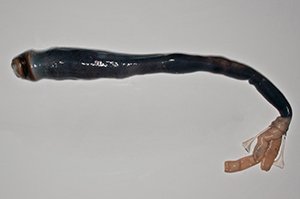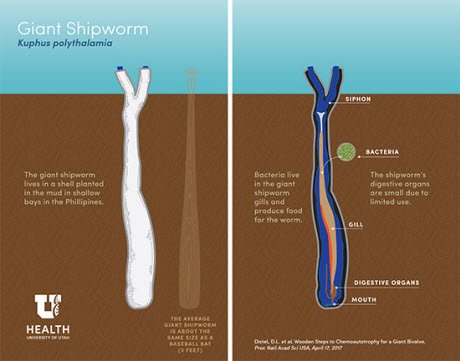Science Fiction Horror Wriggles into Reality with Discovery of Giant Sulfur-Powered Shipworm An international team of researchers were the first to investigate a never before studied species—a giant, black, mud dwelling, worm-like animal

From Lab Manager
Our world seems to grow smaller by the day as biodiversity rapidly dwindles, but Mother Earth still has a surprise or two up her sleeve. An international team of researchers were the first to investigate a never before studied species—a giant, black, mud dwelling, worm-like animal. The odd animal doesn’t seem to eat much, instead it gets its energy from a form of sulfur. The findings, led by scientists at the University of Utah, Northeastern University, University of the Philippines, Sultan Kudarat State University, and Drexel University, will be published online in the Apr. 17 issue of the Proceedings of the National Academy of Sciences.http://www.labmanager.com/news/2017/04/science-fiction-horror-wriggles-into-reality-with-discovery-of-giant-sulfur-powered-shipworm#.WPe1kVXytaQKuphus polythalamia researchersPHOTO COURTESY OF THE UNIVERSITY OF UTAHPeople have known about the existence of the creature for centuries. The three- to five-foot long, tusk-like shells that encase the animal were first documented in the 18th century. “The shells are fairly common,” begins lead investigator Daniel Distel, PhD, a research professor and director of the Ocean Genome Legacy Center at Northeastern University, “But we have never had access to the animal living inside.”
The animal’s preferred habitat was unclear, but the research team benefitted from a bit of serendipity when one of their collaborators shared a documentary that aired on Philippine television. The video showed the bizarre creatures planted, like carrots, in the mud of a shallow lagoon. Following this lead, the scientists set up an expedition and found live specimens of Kuphus polythalamia.
With a live giant shipworm finally in hand, the research team huddled around Distel as he carefully washed the sticky mud caked to the outside of the giant shipworm shell and tapped off the outer cap, revealing the creature living inside.
“I was awestruck when I first saw the sheer immensity of this bizarre animal,” says Marvin Altamia, researcher at the Marine Sciences Institute, University of the Philippines. “Being present for the first encounter of an animal like this is the closest I will ever get to being a 19th century naturalist,” says the study’s senior author Margo Haygood, PhD, a research professor in medicinal chemistry at the University of Utah College of Pharmacy.
Because the animal had never been studied rigorously, little was known about its life history, habitat, or biology. “We suspected the giant shipworm was radically different from other wood-eating shipworms,” says Haygood. “Finding the animal confirmed that.” Altamia continues, “Frankly, I was nervous. If we made a mistake, we could lose the opportunity to discover the secrets of this very rare specimen.” The scientists were then faced with an interesting dilemma—explain why Kuphus is so unusual.

Follow @contentjunkie to stay up to date on more great posts like this one.

This post has been ranked within the top 80 most undervalued posts in the second half of Apr 19. We estimate that this post is undervalued by $2.04 as compared to a scenario in which every voter had an equal say.
See the full rankings and details in The Daily Tribune: Apr 19 - Part II. You can also read about some of our methodology, data analysis and technical details in our initial post.
If you are the author and would prefer not to receive these comments, simply reply "Stop" to this comment.